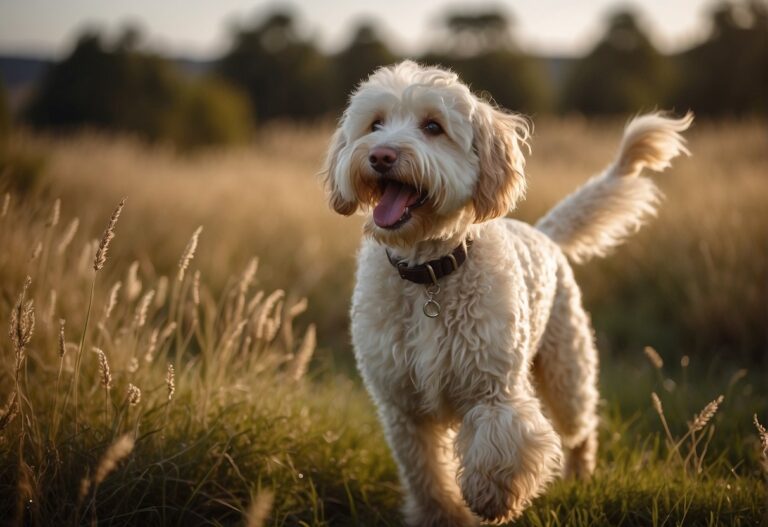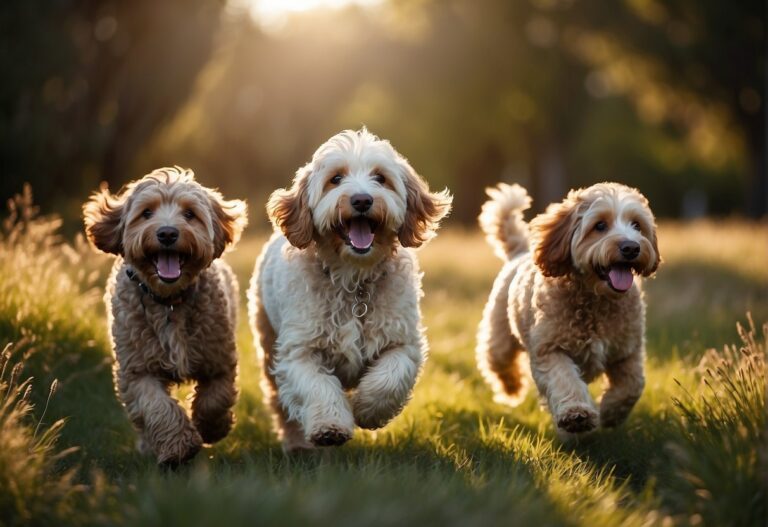Red Australian Labradoodle – Health & Care Tips

The Red Australian Labradoodle is a captivating and distinct version of the Australian Labradoodle, known for its vibrant and luxurious coat color. It stands out not just for its striking appearance but also for its lineage, as part of a global breeding initiative aimed at establishing multigenerational lines that could be recognized as a new pedigree. With origins from the selective breeding of various dogs including the Labrador, Poodle, and other spaniel breeds, the Australian Labradoodle was designed with specific goals in mind: to create a breed with desirable traits, hypoallergenic qualities, and a friendly temperament.
Your interest in Red Australian Labradoodles may have been piqued by their eye-catching color, but it’s important to consider the full spectrum of responsibility that comes with owning this breed. They are characterized by their rich, reddish-brown coat, but beyond their looks, they possess a demeanor that makes them excellent companions.
Health and maintenance are essential aspects of care, with these dogs requiring regular grooming and check-ups to ensure their well-being. Considering their active nature and intelligence, Red Australian Labradoodles thrive on engagement and love to be a part of family activities.
- The Red Australian Labradoodle is sought-after for its unique coat and is part of a breeding project for pedigree recognition.
- These dogs are friendly and intelligent, with a need for regular grooming and engagement.
- Health maintenance and active involvement in the dog’s care are vital for their well-being.
Quick Look at the Breed Traits of Red Australian Labradoodle
Height:
21 – 24 inches
Weight:
50 – 70 pounds
Lifespan:
10 – 15 years
Colors:
Black, apricot, cream, gold, and caramel red,
Suitable for:
Small apartments or houses and families with children.
Temperament:
Intelligent, Sociable, Friendly, Trainable, and Fun Loving
The red Australian Labradoodle is a multi-generational breed known for its vibrant color and harmonious blend of various breed characteristics.
History and Development
The Australian Labradoodle began its journey in the late 1980s, with the aim to create a breed suitable for allergy sufferers. It was initially a cross between a Labrador Retriever and a Poodle, aimed at achieving a service dog that was both hypoallergenic and sociable. Over time, to enhance specific traits like temperament and coat quality, other breeds, such as the English and American Cocker Spaniel, along with the Irish Water Spaniel, were introduced to the lineage.
Your understanding of this breed’s development should note the intention behind its creation. Breeders wanted more than just a first-generation cross; they aspired to establish a stand-alone breed with a consistent set of characteristics.
Breed Standards
When discussing the Australian Labradoodle, you’ll find they are recognized in a plethora of colors including black, apricot, cream, gold, and caramel red, but it’s the red hue that stands particularly eye-catching. Their coats may exhibit various patterns, such as parti, phantom, or sable.
The breed comes in three main sizes:
- Standard (over 53cm at the shoulder)
- Medium (43cm to 52cm at the shoulder)
- Miniature (35cm to 42cm at the shoulder)
As you evaluate the Australian Labradoodle, the focus on predictability in breed standards is clear. It’s not just the aesthetic appeal; the breed’s hypoallergenic coat and friendly demeanor are just as integral to its identity.
Physical and Temperamental Characteristics

In exploring the attributes of the red Australian Labradoodle, you’ll discover a breed that is as visually distinctive as it is sociable and smart. This section sheds light on their physical appearance, demonstrates their engaging personality, and unveils the multifaceted temperament that makes them such a beloved breed.
Appearance
The red Australian Labradoodle is known for its appealing red coat, which comes in a spectrum ranging from deep russet to a light ginger hue. Their size varies, with standard Labradoodles standing about 21-24 inches tall and weighing between 50-70 pounds. Their low-shedding coat not only adds to their aesthetic appeal but also makes them suitable for people with allergies.
Personality
Your red Australian Labradoodle is wired to be intelligent and sociable—qualities that make them highly trainable and fun-loving. They thrive in active households where they can be at the center of the action, linking their human interactions with their vibrant energy.
Temperament
This breed exemplifies an easy-going and loving temperament. They are known to be incredibly loyal and friendly, often forming strong bonds with their families. Mental stimulation is vital for them, as their active minds constantly crave new challenges and learning opportunities. As an owner, you’re tasked with providing regular mental stimulation in addition to their physical exercise needs, ensuring your Labradoodle’s unique character and well-being are nurtured.
Health and Maintenance

Caring for your red Australian Labradoodle involves diligence in grooming, adequate exercise and nutrition, and being mindful of specific health considerations. Ensuring the well-being of your pet requires regular attention to these areas.
Grooming Requirements
Your red Australian Labradoodle’s coat is a defining feature, typically ranging from wavy to curly, which contributes to its hypoallergenic quality. To maintain their coat, grooming is essential. You should brush the coat at least once a week to prevent matting and tangling. Additionally, trimming the hair around the eyes, ears, and paws will keep your dog comfortable and reduce the risk of infections. Maintenance of the coat often means regular grooming appointments every 6-8 weeks to keep their non-shedding coat in good condition.
- Nails: Trimming every 3–4 weeks to prevent discomfort and overgrowth.
- Ears: Clean regularly to prevent ear infections, a common issue in this breed.
Exercise and Nutrition
Regular exercise is crucial for your Australian Labradoodle’s health. Aim for at least 30 minutes to an hour of physical activity daily, suitable for their energy levels. This breed thrives on activities like walking, running, or fetching games.
A balanced diet is also essential for the upkeep of your pet’s health. Choose high-quality, species-appropriate diets to ensure your dog gets the necessary nutrients. Portion control and routine meal times will support optimal health and weight.
Health Considerations
Australian Labradoodles are generally healthy, but they require certain health tests to ensure they remain so.
- Genetic testing: Ensure your dog is VWD, DM, EIC, and IC clear to avoid the respective diseases.
- Hip and elbow scoring: Check for hip dysplasia with a PennHIP test or ensure OFA elbows are normal to prevent joint issues.
- Allergies and skin conditions: Be aware of signs due to lower levels of shedding and dander.
By adhering to a thorough grooming routine, providing regular exercise, and ensuring proper nutrition and health screenings, you contribute significantly to your red Australian Labradoodle’s overall health and happiness.
Ownership and Care

Owning a Red Australian Labradoodle can be a rewarding experience, provided you’re attentive to their specific requirements for training, finding a reputable breeder, and daily living. This energetic and affectionate breed is suitable for families and adapts well in various living situations when properly trained and cared for.
Training and Socialization
Your Red Australian Labradoodle will thrive with early and consistent training and socialization. These intelligent dogs are known for their quick learning ability, and training should start from puppyhood. It’s crucial to use positive reinforcement methods to ensure your Labradoodle is well-socialized and confident around different people, environments, and other animals. For families with children, involving them in the training process can strengthen the bond between them and your pet.
Finding a Breeder
To find a Red Australian Labradoodle, you must contact a breeder who demonstrates a commitment to the breed’s health and temperament standards. The Australian Labradoodle Association of America (ALAA) ensures that its member breeders adhere to strict guidelines. Whether you’re seeking a Standard Australian Labradoodle or a Mini Australian Labradoodle, make sure the breeder provides proof of genetic testing and participates in a guardian program to ensure the well-being of the breeding dogs and puppies.
Living with a Labradoodle
Labradoodle coats require maintenance to keep them looking their best. Regular grooming, including brushing at least once a week and occasional trims, will prevent mats and tangles. Small living spaces can suit a Mini Australian Labradoodle, while the Standard size may need a bit more room to move around. It’s important that your dood is well-exercised and mentally stimulated, making them ideal companions for active individuals or families.
Frequently Asked Questions
When considering the acquisition of a red Australian Labradoodle, a myriad of questions may come to mind. Here’s a concise guide addressing some of the common queries.
How can I find reputable breeders of red Australian Labradoodle puppies?
To locate reputable breeders of red Australian Labradoodle puppies, look for those who are affiliated with recognized organizations like the Australian Labradoodle Association of America. Researching the breeder’s history and asking for testimonials can also be helpful.
What are the differences between a standard Labradoodle and an Australian Labradoodle?
The main difference is their lineage; Australian Labradoodles have additional breeds like the Cocker Spaniel, Wheaten Terrier, and Portuguese Water Dog in their ancestry, resulting in unique traits and temperaments compared to standard Labradoodles.
Is the red coat color common among Australian Labradoodles?
The red coat is a sought-after color in Australian Labradoodles but is not as common as other colors. Selective breeding practices may influence the availability of this vibrant color.
What are the general characteristics of a fully-grown red Australian Labradoodle?
A fully grown red Australian Labradoodle typically exhibits a friendly and intelligent demeanor with a low-to-shedding coat, making them suitable for families with allergy concerns.
How do the various colors of Australian Labradoodles, like apricot or caramel, differ?
Colors like apricot or caramel in Australian Labradoodles vary mostly in hue and tone. Each color, including red, has the same quality and type of non-shedding coat, with differences being purely aesthetic.
What price range can be expected when purchasing an Australian Labradoodle?
The price for an Australian Labradoodle can vary widely based on factors such as breeder reputation, coat color rarity, and lineage. Prices typically range from several hundred to a few thousand dollars.






